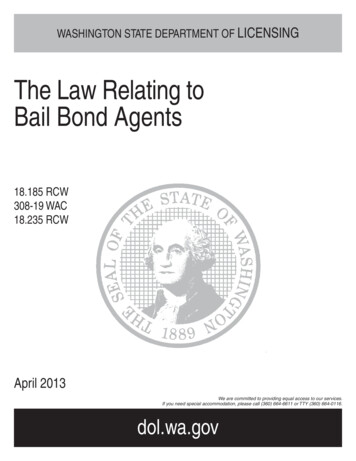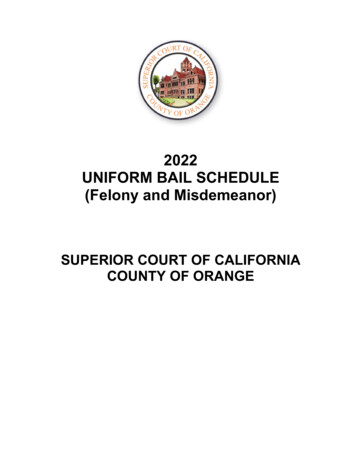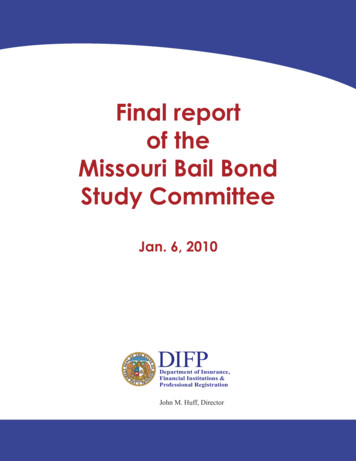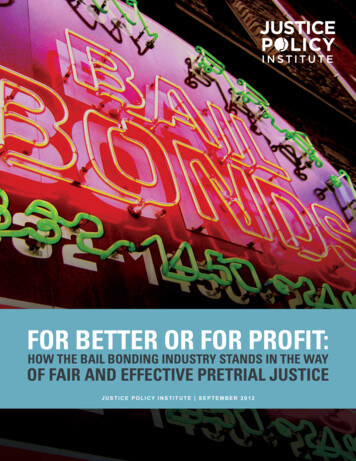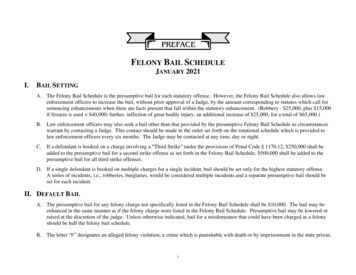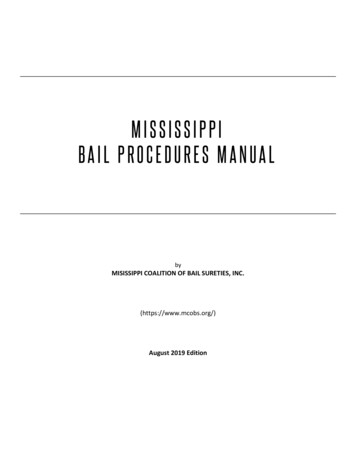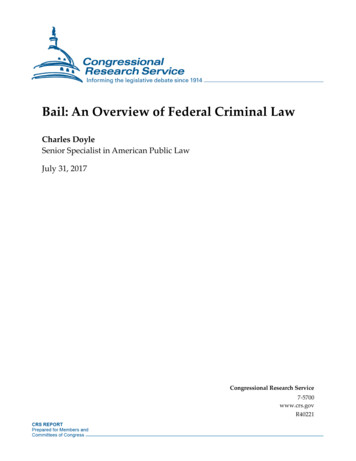
Transcription
Bail: An Overview of Federal Criminal LawCharles DoyleSenior Specialist in American Public LawJuly 31, 2017Congressional Research Service7-5700www.crs.govR40221
Bail: An Overview of Federal Criminal LawSummaryThis is an overview of the federal law of bail. Bail is the release of an individual following hisarrest upon his promise—secured or unsecured; conditioned or unconditioned—to appear atsubsequent judicial criminal proceedings. An accused may be denied bail if he is unable to satisfythe conditions set for his release. He may also be denied bail if the committing judge ormagistrate concludes that no amount of security or any set of conditions will suffice to ensurepublic safety or the individual’s later appearance in court.The federal bail statute layers the committing judge’s or magistrate’s bail options after arrest andbefore trial. He may release the individual upon his promise to return—that is, on personalrecognizance or under an unsecured appearance bond. Alternatively, the judge or magistrate maycondition the individual’s release on the least restrictive possible combination of individual orstatutory conditions. The statute, however, creates a presumption against release when theindividual has been charged with a serious drug, firearms, or terrorist offense. In the case of theseand other serious offenses, the judge or magistrate may deny release on bail if he decides, after ahearing, that no set of conditions will guarantee public safety or the individual’s return to court.The judge or magistrate may also deny the individual bail in order to transfer him for bail, parole,or supervised release revocation proceedings. Bail is available to a more limited extent after theindividual has been convicted and is awaiting a pending appeal.Federal law also authorizes the arrest, bail, or detention of individuals with evidence material tothe prosecution of a federal offense. With limited variations, federal bail laws apply to arrestedmaterial witnesses.Although not specifically mentioned in the federal bail statute, bail is available in extraditioncases under a long-standing Supreme Court precedent which holds that “bail should not ordinarilybe granted in cases of foreign extradition” except under “special circumstances.”This report is available in an abridged version—without footnotes, appendices, most of thecitations to authority, and some of the discussion—as CRS Report R40222, Bail: An AbridgedOverview of Federal Criminal Law, by Charles Doyle.Congressional Research Service
Bail: An Overview of Federal Criminal LawContentsIntroduction . 1History . 1Pretrial . 6Overview . 6Personal Recognizance. 7Conditional Release . 7Rebuttable Presumption . 9Detain for Revocation or Deportation . 10Pretrial Detention . 10Offense-Driven Detention . 11Risk-Driven Detention . 12Detention and Release Orders . 12Bail Pending Sentencing. 13Bail Pending Appeal . 13Consequences of Failure to Appear or Otherwise Honor Conditions. 14Criminal Penalties . 15Amended or Revoked Release Orders . 16Forfeiture of Security . 16Pretrial Service Agency . 17Material Witnesses . 18Extradition . 19AppendixesAppendix A. Federal Crimes with a Maximum Penalty of Death or Life Imprisonment. 22Appendix B. Federal Crimes of Terrorism (18 U.S.C. § 2332b(g)(5)(B)) with a MaximumPenalty of 10 Years’ Imprisonment or More . 28Appendix C. Controlled Substance Offenses with a Maximum Penalty of 10 Years’Imprisonment or More . 31Appendix D. Child-Victim Offenses That Qualify as Predicate Offenses for Bail Purposes . 32ContactsAuthor Contact Information . 33Congressional Research Service
Bail: An Overview of Federal Criminal LawIntroductionIn a criminal law context, bail is most often thought of as the posting of security to ensure thepresence of an accused at subsequent judicial proceedings—that is, “[t]o obtain the release of(oneself or another) by providing security for future appearance.”1 The term itself is lessfrequently used now, however, due in part to the practice of release on personal recognizance,which consists of permitting an individual to pledge his word, rather than his property, for hisfuture appearance. Moreover, today, an individual’s release pending subsequent criminalproceedings is often predicated on conditions other than, or in addition to, the posting of anappearance bond, secured or unsecured. As a consequence, rather than speaking of bail, existingfederal law refers to release or detention pending trial,2 to release or detention pending sentencingor appeal,3 and to release or detention of a material witness.4 This report provides an overview offederal law in each of these areas, as well as in the area of extradition from the United States toanother country.5HistoryAmerican bail law has its origins in England, where it was said that “the right to be bailed . is asold as the law of England itself.”6 Blackstone wrote that “by the ancient common law, before andsince the conquest, all felonies were bailable, till murder was excepted by statute: so that personsmight be admitted to bail before conviction almost in every case.”7 In the beginning, however,officials enjoyed considerable discretion over the circumstances under which bail might begranted or denied.8 The First Statute of Westminister of 1275 limited that discretion when it listedthe criminal offenses which were bailable and those which were not.9Yet, if an individual was imprisoned without charge, the question of whether the crime chargedwas bailable never arose. If an individual was imprisoned without bail and his jailer failed tomake a timely return on his writ of habeas corpus, the right to bail would become meaningless. (Awrit of habeas corpus instructed the sheriff or other custodian to whom it was addressed to returnto the court which issued the writ and to justify the prisoner’s detention.)10 The same was true ifan individual was imprisoned and his bail set at an exorbitant amount.At the dawn of the American colonial period, Parliament had occasion to visit each of theseconcerns. First in the Petition of Right, it precluded pretrial imprisonment without a criminal1Bail, BLACK’S LAW DICTIONARY (10th ed. 2014).18 U.S.C. § 3142.3Id. § 3143.4Id. § 3144.5For a more expansive treatment of many of the same matters see, 3B CHARLES ALAN WRIGHT & PETER J. KLEIN,FEDERAL PRACTICE AND PROCEDURE: CRIMINAL §§ 761-782 (2013 & 2016 Supp.); Forty-Sixth Annual Review ofCriminal Procedure: Preliminary Proceedings – Bail, 46 GEO. L. J. ANN. REV. CRIM. PRO. 382 (2017).61 JAMES FITZJAMES STEPHEN, A HISTORY OF THE CRIMINAL LAW OF ENGLAND 223 (1883 ed.).7III WILLIAM BLACKSTONE, COMMENTARIES ON THE LAWS OF ENGLAND 295 (1769)(transliteration supplied); seegenerally ELSA DEHASS, ANTIQUITIES OF BAIL: ORIGIN AND HISTORICAL DEVELOPMENTS IN CRIMINAL CASES TO THEYEAR 1275 (1940).81 STEPHEN, supra note 6 at 236; William F. Duker, The Right to Bail: A Historical Inquiry, 42 ALB. L. REV. 33, 45-6(1977).93 Edw. I, ch. 12 (1275).10III BLACKSTONE, supra note 7 at 131.2Congressional Research Service1
Bail: An Overview of Federal Criminal Lawcharge and confirmed the availability of habeas corpus relief for those who were held withoutcharge.11 Then in the Habeas Corpus Act of 1679, it imposed a three-day deadline for return on ahabeas writ,12 thus eliminating a custodian’s use of delay to frustrate a pretrial prisoner’s right tobail. Finally, in the Bill of Rights of 1689, it prohibited excessive bail.13In this country, the right to bail appears to have been widely recognized during the colonial periodand in the early years of the Republic. The 1641 Massachusetts Body of Liberties included a rightto bail section:No mans person shall be restrained or imprisoned by any authority whatsoever, before thelaw hath sentenced him thereto, if he can put in sufficient securitie, bayle or mainprise,for his appearance, and good behaviour in the meane time, unless it be in Crimes Capitall,and Contempts in open Court, and in such cases where some expresse act of [the General]Court doth allow it.14The U.S. Bill of Rights and many of the constitutions of the original states featured excessive bailclauses, and less often, right to bail clauses.15The Continental Congress made a right to bail part of the Northwest Ordinance (“. All personsshall be bailable, unless for capital offences, where the proof shall be evident, or the presumptiongreat .”),16 and the First Congress added a similar clause to the first Judiciary Act (“And upon allarrests in criminal cases, bail shall be admitted, except where the punishment may be death, inwhich cases it shall not be admitted but by the supreme or a circuit court, or by justice of thesupreme court, or a judge of a district court, who shall exercise this discretion thereto, regardingthe nature and circumstances of the offence, and of the evidence, and usage of law .”).17The Revised Statutes of 1878 mirrored the provisions of the Judiciary Act.18 The Revised Statutesincluded additional provisions relating to bail for habeas petitioners, and the arrest andsubsequent proceedings concerning individuals previously admitted to bail.19 These continued inplace with little substantive revision until the Bail Reform Act of 1966.20In the mid-1960s, the state of federal bail troubled Congress for two reasons. First, Congressbelieved that, in spite of the presumption of innocence, an accused’s prospects of pretrial releaseturned primarily on his wealth. “Every witness before the subcommittees agreed that, at least innoncapital cases, the principal purpose of bail is to assure that the accused will appear in court for113 Car. I, ch. 1 (1628).31 Car. II, ch. 2 (1679).131 Wm. & M. 2, ch.2 (1689).14The Body of Liberties, 18, reprinted in, WILLIAM H. WHITMORE, THE COLONIAL LAWS OF MASSACHUSETTS 36 (1889).15U.S. CONST. amend. VIII (“Excessive bail shall not be required .”); VA. CONST., BILL OF RIGHTS § 9 (no excessivebail) (1776); PA. CONST., FRAME OF GOVERNMENT, § 28 (“. All prisoners shall be bailable by sufficient securities,unless for capital offences, when the proof is evident or presumption great”), § 29 (no excessive bail) (1776); N.C.CONST., DECLARATION OF RIGHTS art. X (no excessive bail) (1776); MD. CONST., DECLARATION OF RIGHTS, art. XXII(no excessive bail) (1776); VT. CONST. ch.II, § XXV (right to bail), ch.II, § XXVI (no excessive bail) (1777); GA.CONST. art. LIX (no excessive bail); MASS. CONST. pt.I, art. XXVI (no excessive bail) (1780); N.H. CONST. pt. I, art.XXXIII (no excessive bail) (1784); S.C. CONST. art. IX, § 4 (no excessive bail) (1790); DEL. CONST. art. I, § 11 (noexcessive bail), § 12 (right to bail) (1792).16ART. OF CONF. art. II, reprinted in the preface to the first volume of the United States Code at LI.17Act of Sept. 24, 1789, 1 STAT. 73, 91 (1789).18REV. STAT. §§ 1015, 1016 (1878).19Id. at. §§ 1017-1020.20See e.g., 18 U.S.C. §§ 597-601 (1940 ed.); FED. R. CRIM. P. 46 (1944 ed.); 18 U.S.C. §§ 3141-3146 (1964 ed.).12Congressional Research Service2
Bail: An Overview of Federal Criminal Lawhis trial. There is no doubt, however, that each year thousands of citizens accused of crimes areconfined before their innocence or guilt has been determined by a court of law, not because thereis any substantial doubt that they will appear for trial but merely because they cannot affordmoney bail. There is little disagreement that this system is indefensible.”21It further believed that a poor defendant suffered considerable disadvantages as a consequence.“There was widespread agreement among witnesses that the accused who is unable to post bond,and consequently is held in pretrial detention, is severely handicapped in preparing his defense.He cannot locate witnesses, cannot consult his lawyer in private, and enters the courtroom—notin the company of an attorney—but from a cell block in the company of a marshal. Furthermore,being in detention, he is often unable to retain his job and support his family, and is made tosuffer the public stigma of incarceration even though he may later be found not guilty.”22Second, it feared that the existing bail system permit had no real means of holding those chargedwith a crime whose release would pose a danger to the community or someone in the community.Congress addressed the first concern in the Bail Reform Act of 1966, but was unable to reachconsensus on the second, preventive detention, until several years later. “This legislation does notdeal with the problem of the prevention detention of the accused because of the possibility thathis liberty might endanger the public, either because of the possibility of the commission offurther acts of violence by the accused during the pretrial period, or because of the fact that he isat large might result in the intimidation of witnesses or the destruction of evidence. Obviously,the problem of preventive detention is closely related to the problem of bail reform. A solutiongoes beyond the scope of the present proposal and involves many difficult and complex problemswhich require deep study and analysis. The present problem of reform of existing bail proceduresdemands an immediate solution. It should not be delayed by consideration of the question ofpreventive detention.”23The 1966 Bail Reform Act amended federal law to require the pretrial release of an individualcharged with a noncapital federal offense upon personal recognizance or an unsecured appearancebond,24 unless the court determined they were likely to be insufficient to assure the appearance ofthe accused at trial.25 The court was to assess the risk of flight by consideringthe nature and circumstances of the offense charged, the weight of the evidence againstthe accused, the accused’s family ties, employment, financial resources, character andmental condition, the length of his residence in the community, his record of convictions,and his record of appearance at court proceedings or of flight to avoid prosecution orfailure to appear at court proceedings.26Should the court conclude that an accused would otherwise pose a risk of flight, it was to imposethe least restrictive of a series of conditions that included first, third-party custody; then, travel21S.REPT. 89-750 at 6 (1965); see also H.REPT. 89-1541 at 8-9 (1966).S. REPT. 89-750 at 7; see also H.REPT. 89-1541 at 9.23Id. at 5-6.24Personal recognizance is a “type of release [that] dispenses with the necessity of the person’s posting money orhaving a surety sign a bond with the court.” Recognizance: personal recognizance, BLACK’S LAW DICTIONARY (10th ed.2014). An unsecured appearance bond is “a bond that holds a defendant liable for a breach of the bond’s conditions but that is not secured by a deposit of or lien on property.” Id., Bond: unsecured bail bond.2518 U.S.C. § 3146(a) (1964 ed., Supp. II).26Id. § 3146(b).22Congressional Research Service3
Bail: An Overview of Federal Criminal Lawand associational limitations; then, cash or secured bail; and, finally, nighttime incarceration.27The accused was given an explicit right to appeal the imposition of any such conditions.28Release was also required in capital cases and following conviction, unless the court concludedthat no condition or series of conditions could overcome the risk of flight or danger to thecommunity posed by the defendant.29For several years thereafter, debate continued over the wisdom and constitutionality of pretrialpreventive detention in noncapital cases. Some found preventive detention incompatible with theright to bail they considered implicit in either the Eighth Amendment’s excessive bail clause orthe Fifth Amendment’s due process clause or in both.30 Others felt the right was subject toreasonable legislative regulation.31History seemed to provide support for either view. On one hand, the excessive bail clause in theEnglish Bill of Rights was clearly enacted to prevent judges from frustrating the right to bail byrequiring excessive bail. (“Unfortunately, the [Habeas Corpus] Act closed one loophole andopened another. The acknowledgment of discretion in clause III allowed bail to be set atprohibitively high amounts. The Bill of Rights corrected the practice of setting excessive bail incriminal cases .”).32 Moreover, until the mid-20th century, Congress and the vast majority of stateconstitutions had consistently recognized a right to bail in noncapital cases save only when theaccused posed a risk of flight.33 On the other hand, both the English and the federal right to bailhad always been a matter of statute—that is, a matter subject to reasonable legislative regulation.Dicta in various Supreme Court cases seemed equally conflicted. In Stack v. Boyle, the Courtnoted that “this traditional right to freedom before conviction permits the unhampered preparationof a defense, and serves to prevent the infliction of punishment prior to conviction. Unless thisright to bail before trial is preserved, the presumption of innocence, secured only after centuriesof struggle, would lose its meaning.”34 Yet shortly thereafter it observed in Carlson v. Landon thatthe [excessive] bail clause was lifted with slight changes from the English Bill of RightsAct. In England that clause has never been thought to accord a right to bail in all cases,but merely to provide that bail shall not be excessive in those cases where it is proper togrant bail. When this clause was carried over into our Bill of Rights, nothing was saidthat indicated any different concept. The Eighth Amendment has not prevented Congressfrom defining the classes of cases in which bail shall be allowed in this country. Thus incriminal cases bail is not compulsory where the punishment may be death. Indeed, thevery language of the Amendment fails to say all arrests must be bailable.35In 1984, Congress amended federal bail law to permit the use of preventive detention in certainlimited instances when the accused posed a danger to the public or particular members of the27Id. § 3146(a)(1)-(5).Id. § 3147.29Id. § 3148.30E.g., Caleb Foote, The Coming Constitutional Crisis in Bail: I & II, 113 U. PA. L. REV. 959, 1125 (1965).31E.g., John N. Mitchell, Bail Reform and the Constitutionality of Pretrial Detention, 55 VA. L. REV. 1223 (1969).32William F. Duker, The Right to Bail: A Historical Inquiry, 42 ALB. L. REV. 33, 66 (1977).33The Eighth Amendment and the Right to Bail: Historical Perspectives, 82 COLUM. L. REV. 328, 353 (1982).34342 U.S. 1, 4 (1952).35342 U.S. 524, 545-46 (1952).28Congressional Research Service4
Bail: An Overview of Federal Criminal Lawpublic.36 Three years later, the Supreme Court in Salerno held that the legislation offended neitherthe Eighth Amendment’s Excessive Bail Clause nor the Fifth Amendment’s Due Process Clause:In our society liberty is the norm, and detention prior to trial or without trial is thecarefully limited exception. We hold that the provisions for pretrial detention in the BailReform Act of 1984 fall within that carefully limited exception. The Act authorizes thedetention prior to trial of arrestees charged with serious felonies who are found after anadversary hearing to pose a threat to the safety of individuals or to the community whichno condition of release can dispel. The numerous procedural safeguards detailed abovemust attend this adversary hearing. We are unwilling to say that this congressionaldetermination, based as it is upon that primary concern of every government—a concernfor the safety and indeed the lives of its citizens—on its face violates either the DueProcess Clause of the Fifth Amendment or the Excessive Bail Clause of the EighthAmendment.37The Court explained that the regulatory character of the regime immunized it from substantivedue process assault:Unless Congress expressly intended to impose punitive restrictions, thepunitive/regulatory distinction turns on whether an alternative purpose to which therestriction may rationally be connected is assignable for it and whether it appearsexcessive in relation to the alternative purpose assigned to it. We conclude that thedetention imposed by the Act falls on the regulatory side of the dichotomy. Thelegislative history . indicates that Congress did not formulate the pretrial detentionprovisions as punishment for dangerous individuals. Congress instead perceived pretrialdetention as a potential solution to a pressing societal problem. There is no doubt thatpreventing danger to the community is a legitimate regulatory goal. Nor are the incidentsof pretrial detention excessive in relation to the regulatory goal Congress sought toachieve.38Its tailored procedural safeguards shielded it from procedural due process (“Finally, we maydispose briefly of respondents’ facial challenge to the procedures of the Bail Reform Act. Wethink [its] extensive safeguards sufficient to repel a facial challenge”),39 and excessive bailchallenges (“Nothing in the text of the Bail Clause limits permissible Government considerationssolely to questions of flight. The only arguable substantive limitation of the Bail Clause is that theGovernment’s proposed conditions of release or detention not be excessive in light of theperceived evil. We believe that when Congress has mandated detention on the basis of acompelling interest other than prevention of flight, as it has here, the Eighth Amendment does notrequire release on bail”).40 Three Justices—Marshall, Brennan, and Stevens—found themajority’s arguments unpersuasive.41The basic structure of federal bail law is as the 1984 Bail Reform Act left it, although Congresshas made a number of adjustments in the years since, most notably relating to the rebuttablepresumption of flight and dangerousness.4236The Bail Reform Act of 1984 was enacted as chapter I of Title II (Comprehensive Crime Control Act of 1984) ofP.L. 98-473, 98 Stat. 1837, 1976 (1984), 18 U.S.C. §§ 3141-3156 (1982 ed., Supp. II).37United States v. Salerno, 481 U.S. 739, 755 (1987).38Id. at 747-48 (internal citations omitted).39Id. at 751.40Id. at 754.41Id. at 755 (Marshall and Brennan, JJ., dissenting); id. at 768 (Stevens, J., dissenting).4218 U.S.C. § 3142(e)(2), (3).Congressional Research Service5
Bail: An Overview of Federal Criminal LawPretrialOverviewAn individual released prior to trial remains free under the same conditions throughout the trialuntil conviction or acquittal, subject to modification or revocation by the court.43 For that reason,the term pretrial release is understood to include all preconviction release, both before and duringtrial. Under existing federal law, an individual arrested under federal authority must be broughtbefore a magistrate without unnecessary delay.44 Any federal or state judge or magistrate mayqualify.45 The magistrate may order an individual accused of a federal crime either released ordetained prior to trial and conviction.46The law affords the judge or magistrate four options, which it places in descending order ofpreference. First, he may release the accused on personal recognizance or under an unsecuredappearance bond,47 subject only to the condition that the accused commit no subsequent federal,state, or local crime and that he submit a sample for DNA analysis.48 Second, he may release theaccused subject to certain additional conditions.49 Third, he may order the accused detained forbail revocation, parole revocation, probation revocation, or deportation proceedings.50 Fourth, hemay order the accused detained prior to trial.51If the magistrate does not initially release the accused on personal recognizance or conditions, ahearing on the release of the accused must be held “immediately” upon the individual’s firstappearance before the judge or magistrate.52 The accused or the government may request that thehearing be postponed for up to five days—up to only three days when the postponement isgranted at the government’s behest.53 The accused is entitled to assistance of counsel at thehearing and to the appointment of counsel if necessary.54 The accused may testify at the hearing43FED. R. CRIM. P. 46(b).FED. R. CRIM. P. 5(a).4518 U.S.C. § 3041.46“A judicial officer authorized to order the arrest of a person under Section 3041 of this title before whom an arrestedperson is brought shall order that such person be released or detained, pending judicial proceedings, under thischapter.” Section 3141 authorizes arrest by order of “any justice or judge of the United States . any United Statesmagistrate judge . [and] any chancellor, judge of a supreme or superior court, chief or first judge of the common pleas,mayor of a city, justice of the peace, or other magistrate, of any state where the offender may be found.” 18 U.S.C. §3141(a).47Id. § 3142(a)(1), (b).48Id. The Supreme Court largely resolved any questions of the constitutionality of suspicionless collection of DNAsamples from arrestees when it upheld the constitutionality of the Maryland DNA collection statute in Maryland v.King, 133 S. Ct. 1958, 1980 (2013).4918 U.S.C. § 3142(a)(2), (c).50Id. § 3142(a)(3), (d).51Id. § 3142(a)(4), (e), (f).52Id. § 3142(f).53Id.54Id.44Congressional Research Service6
Bail: An Overview of Federal Criminal Lawand present and cross-examine witnesses.55 Evidence may be introduced at the hearing withoutdeference to the rules that apply at a criminal trial.56Personal RecognizanceThe decision to release an accused on personal recognizance or unsecured appearance bond restsupon a determination that the accused poses no risk of flight and no risk of danger to thecommunity or any of its inhabitants.57 The decision requires consideration of four factors: “The nature and circumstances of the offense ”;58“The weight of the evidence against the person”;59“The history and characteristics of the person ”;60 and“The nature and seriousness of the danger to any person or the community thatwould be posed by the person’s release ”61Conditional ReleaseIf the judge or magistrate concludes that personal recognizance or an unsecured appearance bondis insufficient to overcome the risk of flight or to community or individual safety, he maycondition the individuals’ release on a refrain from criminal activity, collection of a DNA sample,and the least restrictive combination of 14 conditions.62 Under the appropriate circumstances, the“community” whose safety is the focus of the judge or magistrate’s inquiry need not be limitedgeographically to either the district or even the United States.63 The 14 statutory conditions are third-party supervision;64seeking or maintaining employment;6555Id.Id.57Id. § 3142(b).58“The judicial officer shall, in determining whether there are conditions of release that will reasonably assure theappearance of the person as required and the safety of any other person and the community, take into account theavailable information concerning-(1) the nature and circumstances of the offense charged, including whether theoffense is a crime of violence, a violation of section 1591, a Federal crime of terrorism, or involves a minor victim or acontrolled substance, firearm, explosive, or destructive device.” 18 U.S.C. § 3142(g)(1).5918 U.S.C. § 3142(g)(2).60“[T]he history and characteristics of the person, including-(A) the person’s character, physical and mental condition,family ties, employment, financial resources, length of residence in the community, community ties
included additional provisions relating to bail for habeas petitioners, and the arrest and subsequent proceedings concerning individuals previously admitted to bail.19 These continued in place with little substantive revision until the Bail Reform Act of 1966.20 In the mid-1960s, the state of federal bail troubled Congress for two reasons.


